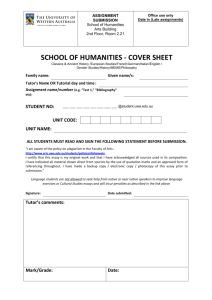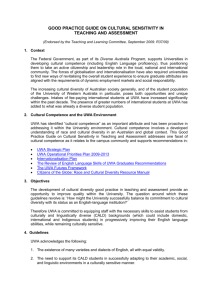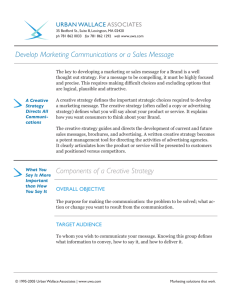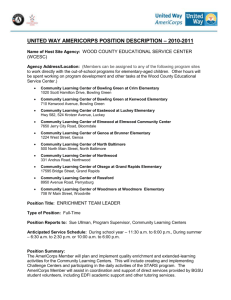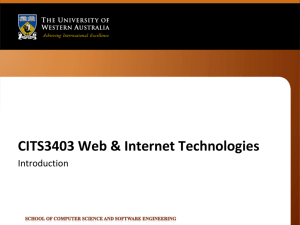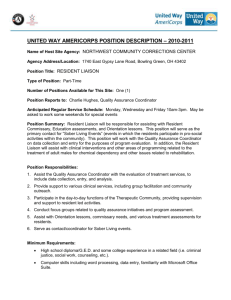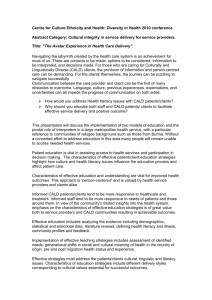uwa cald action plan: 2013 - 2015 - Human Resources
advertisement
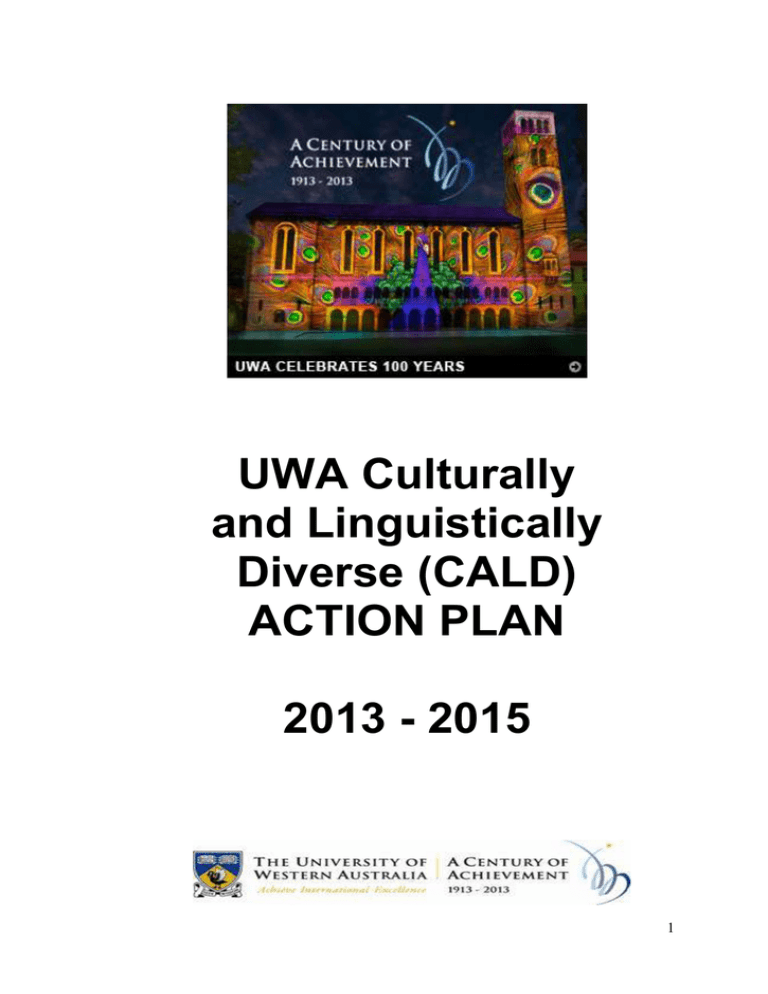
UWA Culturally and Linguistically Diverse (CALD) ACTION PLAN 2013 - 2015 1 UWA Culturally and Linguistically Diverse (CALD) ACTION PLAN – 2013 - 2015 Executive Summary As a premier West Australian and Group of 8 University, The University of Western Australia (UWA) reflects state and national diversity trends in both student enrolment and staff demographics. UWA acknowledges its social responsibility and obligations to staff, students and visitors and over the years, has deliberately sought to promote cultural competence, cultural awareness and inclusiveness across the university community. Founded on contemporary paradigms and grounded in relevant theory, this commitment has been reflected over time in a range of initiatives for staff (including Courageous Conversations About Race and Inclusive Campus Culture), and students (ASPIRE and LACE). Though many of these strategies have evolved independently, a more systematic approach to monitoring, reviewing and developing the area will support the University’s strategic objectives. In short, it remains to unite these initiatives cohesively and comprehensively under one seamless framework. The Culturally and Linguistically Diverse (CALD) Action Plan specifically sets out to create a formal framework under which the various examples of UWA best practice in the area of cultural diversity can sit, to embed good practice structurally, and to support the employment aspirations of existing and prospective staff from Culturally and Linguistically Diversity (CALD) backgrounds. In addition, the Action Plan acknowledges that structural gaps are acted out in predictable ways, and that the system requires monitoring, reviewing and adjustment to promote continued growth and inclusivity. The current scope of the Action Plan is restricted to UWA staff of CALD backgrounds and offers a specific focus on first generation migrants, accents, visible minorities and religious diversity. It does not extend to Indigenous peoples. Uniting the individual strategies under a single “cultural competence” banner will not only result in a more efficient use of resources, but also enhance cohesion, coherence and systemic “ownership” of the Cultural Competence model across the institution. As Critical Race Theory (CRT) and other evidence show, it is only by embedding cultural competence strategies systematically and systemically that lasting social change, cultural shifts and genuine racial equity can be achieved. 2 PART A – Context 1. Aim of a CALD Action Plan The overarching aim is to develop a comprehensive Cultural Competence framework that proactively supports CALD staff at UWA in achieving their full potential. This in turn will assist the University to develop and sustain a culturally competent workforce, well positioned for the future. The Action Plan aims to unite the different elements of the cultural competence ‘conversation’ at UWA in a cohesive manner, and to infuse all areas of planning and practice with cultural awareness. Developed under the auspices of the ViceChancellor’s Equity and Diversity Committee and explicitly seeking to explore the impact of unconscious bias on aspects of employment and decision making, the Plan aims to embed good practice structurally, and support the employment aspirations of existing and prospective staff from CALD backgrounds. 1.2 Background 1.2.1 Definition and scope Broadly defined, individuals from a CALD background are those who identify as having specific cultural or linguistic affiliation by virtue of their place of birth, ancestry, ethnic origin, religion, preferred language, language(s) spoken at home, or because of their parents’ identification on a similar basis. The CALD category is broad and complex, including not only refugee and humanitarian program entrants and new migrants, but also first and second generation migrants. While it is acknowledged that the above definition could apply generically to all Australians, for the purposes of this Plan, the focused effort of the University within the Equity agenda will be on: Staff from first generation migrant groups; Staff from visible minorities; Staff whose first language is other than English; and Religious diversity. The Action Plan will recognise ‘intersections’ in these areas (e.g. religiously diverse migrants from the Commonwealth). The remit will not include Indigenous peoples as it is recognised that the two ‘communities’ are separate and are best served by stand-alone consideration. 3 1.2.2 UWA Diversity Aspirations UWA has a diverse workforce. UWA employees come from many different backgrounds and currently provide a broad range of skills, knowledge and experience that contribute directly to excellence at this University. Within the context of its Strategic Plan and Operational Priorities Plan (2009-2013), UWA is committed to developing strategies that will maximise opportunities for all present and future staff to access and participate actively in employment. The UWA Action Plan directly addresses Diversity aspirations in relation to: 1. The UWA Operational Priorities Plan (2009-2015) in relation to Priority PR 1.4 and ED 1.4, namely, Create an equitable and diverse work environment and Further equip staff to work with a diverse student population; 2. Australia’s National Human Rights Action Plan to celebrate Harmony Day annually (Priority 215); and 3. Australia’s National Human Rights Commission’s Anti-Racism Strategy. Flowing from these broader aspirations, other University-based aspirations include: Supporting international excellence in a competitive global environment through fostering the success of staff from diverse backgrounds, providing an international benchmark for facilities and standards in teaching and learning, and international engagement. Positioning UWA as an Employer of Choice with inclusive employment practices that enable CALD individuals to participate fully in the workplace. Tapping into the ‘talent’ pool of CALD employees, releasing the potential at UWA for creativity and innovation, and building on the foundations and achievements of the UWA Workforce Diversity Strategy (2002-2009). Enhancing esteem for the University by promoting an inclusive culture, that reduces claims of potential or systemic discrimination based on race, ethnicity, nationality or religious belief. 1.2.3 Cultural Competence Achievements at UWA to date The Cultural Competence strategy for staff at UWA over the past decade has taken the approach of engaging (invite the conversation), sustaining (keep the conversation going), and deepening (extend the conversation to deeper levels of knowledge, understanding and action) [Appendix A]. There are also a number of initiatives and policies specifically targeted at students regarding cultural awareness, diversity and inclusiveness [Appendix B]. Overall, UWA has embraced the need to provide cultural competence training, and aspires to create a comprehensive framework for developing this attribute. The inception of local innovative workshop, training and awareness programs in addition to a national community of practice 4 profile, has cemented the University’s position as the flagship for cultural competence training in the sector and as a national leader in the area. 1.2.4 Demographic Contexts (our state, the region & future trends) The 2011 WA census1 confirms that WA is still “Australia’s most culturally, linguistically and religiously diverse state”.2 Since the 2006 Census the proportion of WA people born overseas has risen from 27.1% to 30.1%, and usual residents who speak a language other than English at home increased from 11.6 to 14.5% of the WA population.3 While the “overseas born” demographic continues to originate primarily from Commonwealth countries,4 there is a definite change in the composition of the top five countries of origin with India replacing Italy in the top 4.5 Significantly, there is also a reported change in religious affiliation with increases in Islamic, Buddhist and Hindu affiliations, and an overall decline in Christianity.6 The staff and student population at UWA broadly reflect the Census findings. As at March 2011, more than 22% of staff reported being from culturally diverse backgrounds.7 UWA students are similarly diverse with indigenous, overseas-born, and international students well-represented in the general student population, reflecting a range of 80 different languages.8 Responding to this diversity, and in line with its policies and procedures promoting inclusivity and cultural consciousness, UWA has a number of specifically targeted CALD-focussed initiatives (see Appendices A & B). The Action Plan reflects the aspirations of the University going forward not just to reflect the diversity of the WA community, but to prepare students and staff to engage with changing global opportunities. Recent inquiries9 have emphasised the need to develop an ‘Asia Capable’ workforce,10 and to prepare for the so-called ‘Asian Century’.11 Thus the CALD Action Plan looks not only to develop the University’s local capacity, but also to extend its capability to participate globally in a changing economic, political and social environment. 1 Available at www.omi.wa.gov.au. Ibid. 3 Ibid. 4 The top 5 countries of origin in the WA population are UK, New Zealand, South Africa, India and Malaysia (2011 Census). 5 Ibid. 6 Ibid. 7 UWA Commencing Staff Census, March 2011. 8 Cf, UWA CDIP Toolkit 2009. 9 Magalogenis, G. “Our future is as Asia’s nation of immigration.” The Weekend Australian, 15-16 September, 2012at www.theaustralian.com.au; “Push to develop an ‘Asia capable’ workforce”. Campus Review 24 September 2012 at www.campusreview.com.au/blog/news. 10 “Push to develop an ‘Asia capable’ workforce”. Campus Review 24 September 2012 at www.campusreview.com.au/blog/news. 11 Magalogenis, G. “Our future is as Asia’s nation of immigration.” The Weekend Australian, 15-16 September, 2012at www.theaustralian.com.au. 2 5 1.2.5 Identifying the ‘Gap’ Research demonstrates that specific cultural (CALD) gaps exist in all Western liberal democracies, reflected in various systems and institutions, and that they play out in relatively predictable ways. Such gaps may be illuminated by applying analytical frameworks such as Critical Race Theory (CRT).12 CRT has emerged as a “powerful theoretical and analytical framework”13 within the education context over the last decade. It offers 5 tenets through which the educational context can be viewed with regard to race14, thus providing a useful analytical lens through which systemic racism15 can be identified, examined and “unpacked”. CRT is underpinned by a commitment to social justice and social change, which is why its use has proven so effective in educational settings. Making the consideration of cultural diversity a conscious and deliberate feature of all facets of University life assists in reducing systemic discrimination stemming from both conscious and unconscious bias based on race, ethnicity, accent/language competence, nationality or religious belief. CRT may be translated within the university context as follows: 1. The language and dialogue of the institution may not offer sufficient opportunities for minority voices to be heard, perpetuating racial stereotypes; 2. “Racism” is accepted as a permanent feature that cannot be eradicated entirely and continues to be manifested in subtle and covert ways in the institution; 3. Access to and use of educational opportunities within the institution are more often afforded to those from the majority culture; 4. The majority culture in the institution controls the flow and speed of change to maintain the status quo and power ‘differential’; and 5. Some approaches preferred by the institution (e.g. “colour blindness” and incremental change) may not result in actual or lasting change. If the “gaps” identified by CRT can be assumed to exist, then a systematic framework can be established to monitor good practice and to ensure that it continues. 12 De Cuir, Jessica and Adrienne Dixson (2004) ‘”So When It Comes Out, They Aren’t That Surprised That It Is There”: Using Critical Race Theory as a Tool of Analysis of Race and Racism in Education’ in Educational Researcher, June/July 2004, 2631. 13 Ibid., p. 27. 14 Race in the UWA context means the socially constructed meaning attached to a variety of attributes including but not limited to skin and eye colour, hair texture, bone structure and accent of people in Australia and elsewhere. 15 Systemic Racism (aka Institutionalised racism) refers to institutional policies, practices and systems that result in the unjustified negative treatment (conscious or unconscious) of members of a racial or ethnic group. 6 1.3 Rationale 1.3.1 Unconscious Bias and Privilege Unconscious bias in the workplace is characterised as making decisions in favour of one group, to the detriment of others, without realising one is doing so. Individuals are hardwired to react in certain ways and everyone has subtle hidden barriers or ingrained stereotypes of which they are often unaware. Unconscious bias may inadvertently perpetuate the privilege of the majority (numerically and culturally/racially) group. This phenomenon has been explored in relation to barriers that have impeded people in the workplace based on subjective factors that are not actually related to individual performance or qualifications (e.g. the ‘Bamboo ceiling’).16 The literature suggests that these hidden barriers include language17, accent, skin colour, lack of perceived ‘fit’ owing to cultural distance, and a low level of awareness of racial matters. They can have an impact on such workplace factors as decision-making, recruitment, access to professional development opportunities, and staff progression. While the term “bamboo ceiling” was originally coined to describe and explore a lack of career progression among Asian-Americans, it can be extended to include other members of the Australian CALD community who may experience similar barriers to opportunity and advancement. Recent Australian studies demonstrate unequivocally that unconscious bias (as well as more conscious and overt forms of discrimination) can affect recruitment, employment and advancement of CALD staff. One such Australian study analyses the experience of racialised minority groups in the health profession.18 According to the authors, the study not only examines racism in a specific workplace context, but also ‘exposes the subtle, mundane nature of contemporary racism’.19 Another Australian study (based on three large-scale field experiments) revealed unconscious bias by exposing would-be employers and recruitment agencies to a range of every-day workplace choices.20 The study revealed that based on name and accent alone, CALD applicants would be required to apply for 50% more jobs than applicants from non-diverse backgrounds to achieve an interview.21 In terms of WA, a report on Refugees to WA found that institutional or systemic discrimination was a significant factor in skilled refugees experiencing The term “Bamboo ceiling” was coined in Jane Hyun's book, Breaking the Bamboo Ceiling: Career Strategies for Asians (2005). 17 Note that to be eligible for admission to a UWA undergraduate or postgraduate-coursework program, every student must demonstrate satisfactory performance in a UWA-approved test of English. This is also the case when English is their first language. This English Language Competence (ELC) requirement is set out in the University Policy on English Language Competence at universitypolicies.uwa.edu.au. Staff are not required to prove or test for ELC in a like manner. 18 Mapedzahama, V., Rudge, T., West, S and Perron A. Nursing Inquiry 2012; 19: 153–164. 19 Ibid. , Synopsis. 20 Booth, Alison, Andrew Leigh and Elena Varganova (2009). ‘Does Racial and Ethnic Discrimination Vary Across Minority Groups? Evidence from Three Experiments’ at http://people.anu.edu.au/andrew.leigh/pdf/AuditDiscrimination.pdf. 21 Ibid. 16 7 “unemployment, loss of occupational status and secondary niche market placement in the employment market”. Drawing on earlier studies (Rydgren 2004; Essed 1991; Shih 2002), the report concluded that recruitment practices that discriminate against minorities include not only expressed requirements such as English language proficiency, qualifications and assessment procedures, but also “soft skill” requirements such as having the right attitude, getting along well with co-workers, and having good communication with customers.22 Following from this latter finding, it has recently been mooted that contemporary recruitment criteria including “corporate fit” and “attitude” might represent a new form of “tacit” workplace discrimination, further tapping into unconscious bias.23 The Australian research highlights the need to investigate the existence of potential barriers in the workplace, and to identify, name and ameliorate unconscious bias. 1.3.2 A culturally competent university aims to dismantle the twin barriers of Unconscious Bias and Privilege by proactively encouraging/supporting: the increased participation of visible and invisible minorities, valuing and affirming diverse ‘voices’ and ‘knowledge’; culturally responsive orientation/induction processes; a critical mass of staff with a high level of cultural ‘consciousness’ a culturally responsive policy environment and the establishment of appropriate cultural protocols including opportunities to participate in decision-making; culturally diverse perspectives in teaching and learning; and meaningful community engagement with culturally diverse communities. To support the aspiration of becoming a culturally competent University, an overarching plan has been developed, with strategic initiatives assembled under a formalised framework. A phase of “managed coherence” is proposed that draws together the suite of cultural competence offerings at the University under the key result areas of Employment, Inclusive Culture, Cultural Awareness and Leadership as detailed in Part B of this document. 22 Colic-Peisker, Val and Farida Tilbury (2011). Refugees and Employment: The effect of visible difference on discrimination at http://www.cscr.murdoch.edu.au/visible_difference_report.pdf. 23 ‘Corporate fit and attitude equals discrimination by Canberra recruiting firms’ in Riotact at http://the-riotact.com/corporate-fitand-attitude-equals-discrimination-by-canberra-recruiting-firms/73763. 8 APPENDIX A Cultural Competence Achievements at UWA to date (Staff) The strategic and proactive steps taken in the CALD space at UWA to date include: (2001-2005) Local level “championing” of cultural awareness through the Workforce Diversity Strategy, and Equity and Diversity workshops; (2006) Introduction of a generic anti-racism program, Citizens of the Globe – In Tune with Difference, created by Equity and Diversity at UWA with the assistance of a Department of Immigration and Multicultural Affairs (DIMA) community grant; (2006) Development of Citizens of the Globe Race and Cultural Diversity Resource Manual (funded by a UWA Teaching Fellowship) to extend the critical cultural diversity model and provide a practical resource for raising key theoretical concepts in the UWA curriculum; (2008) Inception of Courageous Conversations About Race (CCAR) facilitated workshops for UWA staff; (2008-2009) Customisation and dissemination of the Cultural Diversity and Inclusive Practice Toolkit (CDIP); (2009) Approval of University Policy on English Language Training Leave; (2009-2010) Indigenous Dialogues and roll out of More Courageous Conversations About Race (MCCAR); (2010-2011) Development of the CCAR Facilitator Development Manual and workshops on cultural competence facilitation within a national community of practice within the higher education sector; (2011) Launch of national Conversations About Race Facilitator Development Manual; (2012) Participation in National Human Rights Commission Anti-Racism Strategy; (2012) Development of UWA CALD Action Plan; English Language Support for Teachers Program; International Postgraduate Tutors Program. 9 APPENDIX B Cultural Competence Achievements at UWA to date (Students) The strategic and proactive steps taken in the CALD space at UWA to date include: ASPIRE: a community partnership model that encourages students who would not normally consider university as an option to see the benefits and opportunities that university study offers. Many of the participating students are from CALD backgrounds; FAIRWAY UWA: offers an alternative pathway to UWA by supporting eligible students during Year 12. The program recognises that students who face financial hardship and other difficult circumstances are often prevented from achieving their true academic potential; Language and Cultural Exchange (LACE) program is open to postgraduate students and staff and provides opportunities for people from many different countries and cultures to meet up socially; Cultural competence/Race training embedded in UWA curriculum across 7 faculties and in 3 Post-Graduate Professional programmes; (2008-2009) Customisation and dissemination of the Cultural Diversity and Inclusive Practice Toolkit (CDIP); (2009-2010) Indigenous Dialogues; (2012) Participation in National Human Rights Commission Anti-Racism Strategy; (2012) Development of UWA CALD Action Plan. 10 PART B – IMPLEMENTATION The broad key areas for “Action” are Employment (Build), Inclusiveness (Promote), Cultural Competence (Create) and Leadership (Connect) [below]. UWA CALD ACTION PLAN: 2013 - 2015 Key Result Areas (KRAs) Strategy Employment (Build – Attraction, recruitment, retention, engagement) 11 Devise means to capture and meaningfully analyse qualitative and quantitative data around CALD employment and workforce participation at UWA (Is there a ‘CALD’ ceiling? Are there pockets of underrepresentation? Is Affirmative Action required? If so, in what areas of activity). Develop targeted recruitment, retention and development strategies reflective of diversity aspirations. Induction processes reviewed to include CALD sensitivity. Professional development /culturally specific support. Practice Remove any structures and/or practices that may act as a barrier to recruitment, retention and career advancement of CALD staff e.g. selectionpanel training and composition to include CALD representation where possible. Develop CALD-inclusive processes for enhanced participation in decisionmaking e.g. committee membership Recognise employee entitlement to “English Language Training Leave” (see UWA Policy) and English Language Support, and the benefit of its use in PDR/PAR discussions. Policy Develop and publish a comprehensive UWA Cultural Diversity policy statement. Consider amendments to Position descriptions / Job Advertisements where appropriate to stipulate competency in a language other than English and other typically CALDspecific skills that might value add. Responsibility (*) Senior Deputy ViceChancellor Director HR Heads of organisational units Key Result Areas (KRAs) Inclusive Culture (Promote visibility and sensitivity to foster a sense of cultural safety and acceptance) Strategy Augment existing ‘infrastructure’ to support an inclusive workplace environment. Promote UWA’s public image and reputation as an inclusive organisation that supports and values cultural diversity. Implement (augment existing) initiatives to enhance cultural competence and racial ‘consciousness’ for all staff. Provide information and clarification around CALDspecific terminology. Scope new and emerging diversity phenomena and best practice models from a range of employment sectors to inform UWA best practice. Build/Embed Cultural Awareness (Create the climate through education and training) Implement initiatives to provide targeted support to staff from CALD backgrounds e.g. ‘culturally safe’ conversation space, CALD staff network. Practice Policy Provide/enhance facilities for CALD staff as required e.g. facilities for staff with compulsory religious observance requirements (24). Development of a Cultural Competence Facilitators Network to conduct Courageous Conversations about Race / Diversity Dialogues within Faculties/ organisational divisions. Responsibility (*) Inclusion of explicit CALD expertise in complaint management policies, procedures and processes Director, HR Embed cultural strategies (e.g. expressed capacity) in positions descriptions & recruitment training Director, HR Associate Director, Equity and Diversity Heads of Organisational Units Associate Director, Equity and Diversity (1) Religious observance requirements are said to be ‘compulsory’ if they are a requirement of an individual’s religious observation over which they cannot exercise personal choice in terms of when or where the observance takes place (e.g. Ramadan, Sabbath days, prayer requirements, religious dress requirements etc.) 12 Key Result Areas (KRAs) Leadership – UWA and beyond (Connect diversity aspirations with inclusive ‘best’ practice) Strategy Embed responsive crosscultural management and leadership strategies across the University and broader higher education sector. Link existing, and new, CALD initiatives to the Leadership Framework. Practice UWA executive and senior managers to support, oversee and be accountable for the management of CALD strategies. Consolidate and extend the National Community of Practice around Race and Cultural Diversity (*) Includes Deans, Heads of School, UWA Librarian, Senior Managers Group (Professional and Academic) 13 Policy Audit key UWA policies to ensure cultural competence aspirations are imbued within them e.g. Leadership Framework Responsibility (*) Senior Deputy Vice – Chancellor Heads of organisational units Director, HR Senior Diversity Officer
